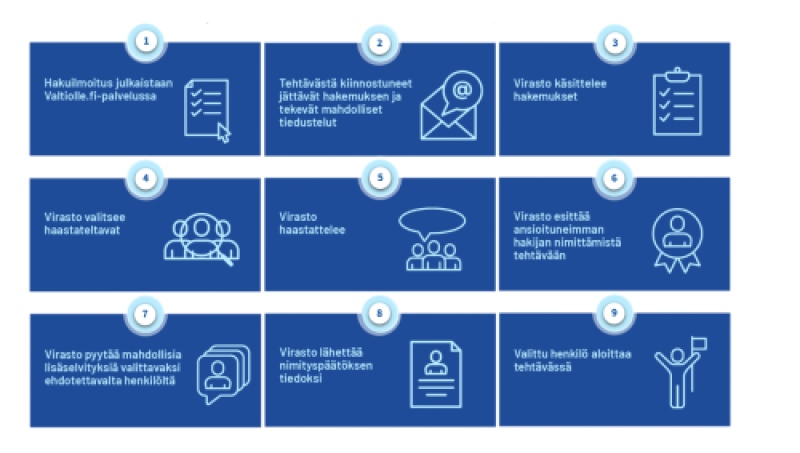
Recruitment in the State Sector – How It Works
Recruitment for state positions includes both permanent and fixed-term appointments. In addition, there are positions based on employment contracts. A fixed-term appointment can be made on specific legal grounds, such as parental leave substitutions.
Each agency is responsible for its own workforce planning and recruitment. Some positions are filled through the agency’s own training programs, while for others, employer-provided training is the only entry route.
Submitting an application through the Valtiolle.fi service ensures that all required information is included. If you are unable to use Valtiolle.fi and instead send your application to the registry address provided in the job advertisement, please make sure to include the recruitment ID number in your application.
Requirements and expectations described in the advertisements
The job advertisements list the training, experience and competence that applicants are required to have. In addition to these features, an advertisement may contain statutory qualification requirements. These are absolute requirements based on law that a person must meet in order to be selected. Without the required qualifications, an applicant cannot be invited to an interview. Therefore, potential applicants should read through the advertisements carefully.
Open application
The state can also hire individuals without a public application process for a fixed-term position for a duration of less than two (2) years. Such advertisements are not published at the Job Search Service.
Applicants can submit an open application to the state, in which they specify the field of work and/or agency they would like to work for. Only temporary positions with the state are available through open applications.
1. Preparation
- Job analysis: Define the duties, complexity, and future competence needs of the position.
- Job description and selection criteria: Drafted as the basis for the job advertisement.
- Internal arrangements: Assess the possibility of filling the position internally.
- Appointment authority: Determine who makes the appointment (agency, government, president).
2. Public Call for Applications
- Job advertisement: Published on the Valtiolle.fi service (also in Swedish if needed).
- Application period: At least 14 days.
- Visibility: Additional communication if needed (e.g., social media, direct search).
3. Evaluation
- Application review: Check eligibility and other criteria.
- Interviews: Often multiple rounds; may include assignments.
- Suitability assessment: External expert used if necessary.
4. Selection
- Appointment decision: The most qualified candidate is selected objectively.
- Additional checks: If needed, security clearance, health check, declaration of interests.
- Appointment memo and decision: Justified and public decision with appeal instructions.
5. Implementation of the Decision
- Notification: Sent to all applicants, usually via Valtiolle.fi.
- Legal validity: Verified before the position is assumed.
- Archiving and evaluation: Documents archived and the selection process reviewed.
6. Onboarding and Orientation
- Introduction and start of work for the new official.
- Transparency and fairness
- Fulfillment of eligibility requirements
- Objective comparison of merits
- Applicant communication and good governance
- Public access and data protection
State recruitment is governed by several laws, including the Public Servants Act, the Administrative Procedure Act, the Equality Act, the Non-Discrimination Act, and the Act on the Openness of Government Activities. These laws aim to ensure that applying for a job in the state sector is fair, transparent, and equal.
How are these rules reflected in practice?
- Job openings are announced publicly, usually on the Valtiolle.fi website.
- Applicants are compared based on their skills and experience. Anonymous recruitment is sometimes used.
- The selection decision is made fairly and with justification. Discrimination is prohibited.
- All applicants are informed of the selection decision. Everyone is told who was selected and on what grounds.
- Applications submitted to the state are, as a rule, public as soon as they are received by the authority. Public information may be disclosed upon request, unless the information is confidential under the law. An applicant may request that their name be kept confidential, but the authority will act in accordance with the Act on the Openness of Government Activities. Read more: See the Frequently Asked Questions section Are the applications submitted to the state public?
--
The Ministry of Finance’s website provides information about state recruitment and lists the related guidelines.
Because the state recruitment process aims to be as transparent as possible, a set of process-related instructions has also been prepared for agencies — openly available for everyone to read.
Sometimes applicants may feel that government recruitment processes take a long time. This feeling is often justified, as the recruitment process in the public sector is regulated not only by law but also by various rules and guidelines.
Recruitment involves several stages, each of which is necessary:
- A public application process, which requires certain timeframes (e.g., the application period must be at least 14 full days).
- A multi-phase evaluation, starting with checking eligibility criteria (e.g., a specific degree) and followed by a merit-based comparison that emphasizes equality.
- Bureaucratic decision-making, as appointments to public positions may require approval at multiple levels.
Due to this structured and multi-step process, a single government recruitment can often take at least 3–5 months.
While government recruitments may take time, the processes are generally more transparent than in the private sector.
- Because of the long duration, we aim to pay special attention to open and timely communication with applicants, keeping them informed about the progress of the recruitment process.

1) The job announcement is published on the Valtiolle.fi service
2) Interested candidates submit their application and make any inquiries
3) The agency processes the applications
4) The agency selects candidates for interviews
5) The agency conducts interviews
6) The agency proposes the most qualified candidate for appointment
7) The agency requests any additional clarifications regarding the proposed candidate
8) The agency sends the appointment decision for information
9) The selected candidate begins in the position
Työtä Suomen parhaaksi -training (eOppiva, 2025)